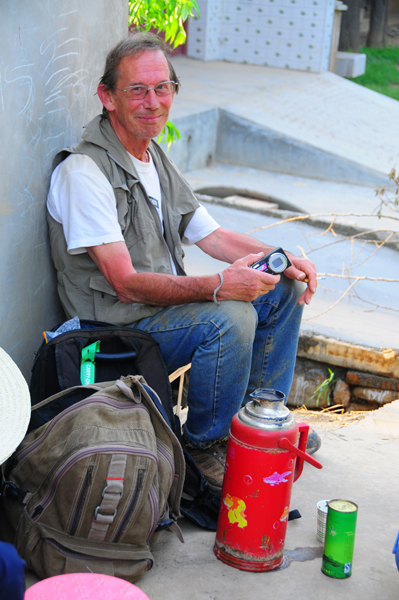Robin Dennell - Curriculum Vitae#
Education:- 1966-1969: Pembroke College, Cambridge, B.A. in Archaeology and Anthropology.
- Part I: 1st Class; Part II (Palaeolithic option): Upper Second
- 1969-1973: Ph.D. student, Faculty of Archaeology and Anthropology, University of Cambridge
- 1977: Ph.D., University of Cambridge: (Topic: Early farming in South Bulgaria: VIth to IIIrd Millenium b.c.; subsequently published as a monograph)
- University of Sheffield, 1973-2009:
- Lecturer, 1973-1983; Senior Lecturer 1983-1994, Reader 1994, Personal Chair, 1995
- (2009: I took voluntary severance to relocate to Exeter, where my wife and son live)
- Lecturer, 1973-1983; Senior Lecturer 1983-1994, Reader 1994, Personal Chair, 1995
- University of Exeter, 2013-14: Professor of Archaeology
Research career: this comprises three main parts:
- archaeobotany and the early history of farming: associated fieldwork: Bulgaria 1970-1972, Iran 1975-1978
- palaeolithic Pakistan: associated fieldwork: 12 seasons of fieldwork, 1981-1990 and 1999 in the Soan Valley and Pabbi Hills investigating Upper Palaeolithic landscapes (Soan Valley) and early palaeolithic and early Pleistocene landscapes (Soan Valley and Pabbi Hills)
- palaeolithic China: 10 visits since 1999; participated in excavations at Shuidonggou, Inner Mongolia (2007) and fieldwork in the Loess Plateau (2010-present)
Selected professional activities in last 10 years include:
i) Collaboration with Chinese colleagues at the Institute of Vertebrate Palaeontology and Palaeoanthropology (IVPP), Beijing, in excavation and fieldwork in North and Central China, and publication.
ii) Participation as a member of the Scientific Committee of the UNESCO HEADS (human evolution, adaptation, dispersal and social development) programme under Dr. Nuria Sanz, aimed at raising the representation of human evolution and early prehistoric sites on the list of World Heritage Sites. Meetings of this programme since 2009 have been held in Burgos, Addis Ababa, Jeongkok (S. Korea), Tubingen, Puebla (Mexico) and Ankara. I am also a member of ICOMOS.
Editorial Boards
- 2015-: Associate Editor of the Journal of Human Evolution
- 1984-1987: Co-editor of Journal of Archaeological Science
Biography
Although I was trained primarily as a European prehistorian (e.g. my Ph.D. on SE Europe and my first book, European Economic Prehistory, 1983), I have always believed that our understanding of prehistoric Europe is greatly enhanced if it is studied within the wider context of continental Eurasia. This is particularly the case when considering its earliest colonisation, the dynamics of its occupation during the Pleistocene, and its colonisation by Homo sapiens ca. 40 ka. Examples are my 1996 paper with Wil Roebroeks (Leiden) on the earliest colonisation of Europe, my 2005 Nature review paper with Wil Roebroeks on the colonisation of Eurasia, and my recent papers (listed above) on hominin demography and settlement in Middle Pleistocene Europe.
Because European palaeolithic archaeologists have far less awareness of the palaeolithic record of Asia than of Africa, much of my intellectual effort in the last decade has been spent in i) attempting to situate the European palaeolithic record within a wider Eurasian context; and ii) synthesising the Asian palaeolithic record to provide European researchers with the necessary Asian background to contextualise European data. The former is illustrated by my recent papers on Early and Middle Pleistocene Europe, and the latter by my volume "The Palaeolithic Settlement of Asia" (Cambridge Univ. Press, 2009) which ended its coverage at the last interglacial, ca. 125 ka-ago. The early appearance of Homo sapiens in southern Asia and Australia is covered in my recent (2014) co-edited volume, published by Cambridge Univ. Press, and I am currently co-editing another volume, this time for a special issue of Quaternary International, on the early history of modern humans in Northeast Asia, including China.
One of my main concerns in the last 20 years has been with the “big ideas” that underpin study of the EurAsian palaeolithic: i) Out of Africa 1, or the initial dispersal of hominins from Africa into Asia and Europe, allegedly ca. 1.8 Ma; ii) Out of Africa 2, or the dispersal of Homo sapiens from Africa in the last 100,000 years; and iii) the Movius Line, by which the early palaeolithic record of East Asia is seen as fundamentally different from that of West and South Asia, and Europe. Several of my papers are highly critical of established thinking, and have presented alternative models.
Since 2009, I have also been involved with UNESCO as a member of the scientific committee of the HEADS (human evolution, adaptation, dispersal and social development) programme that is aiming to increase the representation of human evolution sites with World Heritage status. This has involved meetings in Burgos, Tubingen, Addis Ababa, South Korea, Mexico and Indonesia. In May 2014 I will be one of the speakers at the opening of a new museum at the World Heritage site of Zhoukoudian, China.


